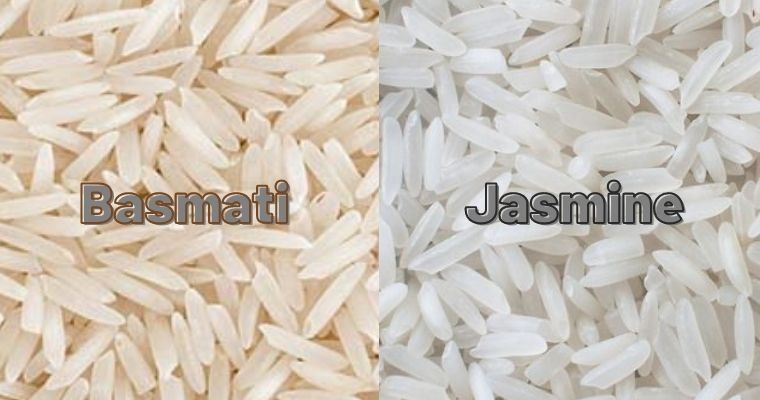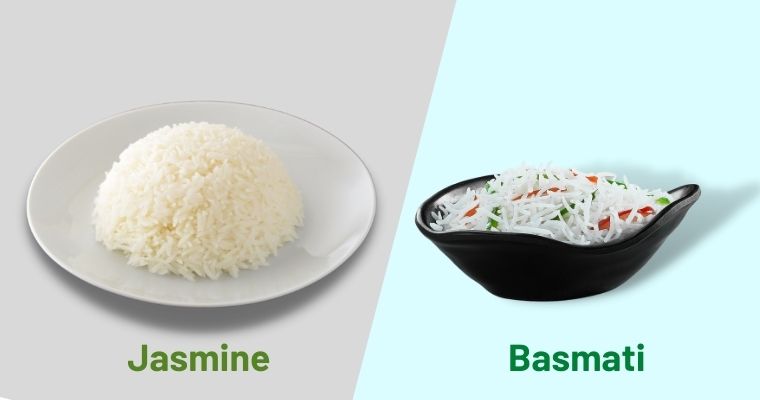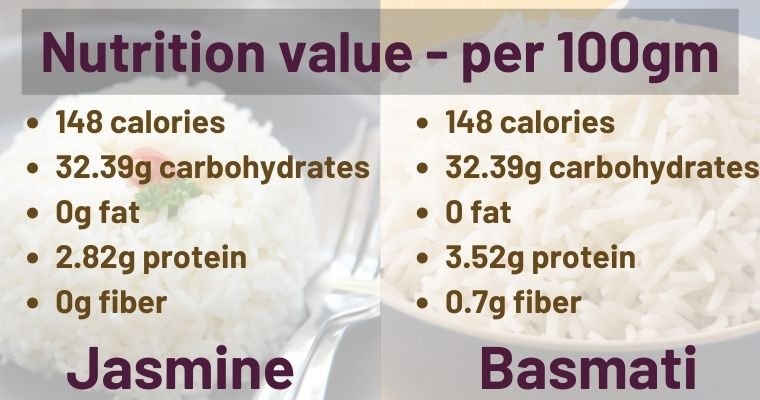Last Updated on April 5, 2022
Do you have any idea about the difference between jasmine rice and basmati rice? There are forty thousand varieties of rice all over the world. But, today, I will discuss two kinds of rice: Jasmine and Basmati, and the difference between them. It is confusing to pull out the dissimilarities between the two types of rice. Both of them are popular sources of long grains. Both jasmine and basmati rice have a well and popcorn-like aroma, and as staple foods, they are sources of carbohydrates. You will like both of them for their excellent fragrance, but they are a little costlier than white rice and other general kinds of rice. By the sight of long grain and aromatic rice varieties, both rice is similar. But, here I am presenting some differences between jasmine rice and basmati rice, which made one variant from the other.
What is basmati rice?
Basmati is a kind of long-grain, well-fragranced, and aromatic rice that grows mainly in India, Pakistan, and some regions of Nepal. It is a commonly used item in Indian and South Asian recipes. Basmati has a floral and nutty flavor; thus, it is used to make roasted or braised meat curries, and it is the main ingredient of biryani. The name “Basmati” comes from an Indian word that means fragrance.
What is jasmine rice?
Jasmine rice is also called Thai fragrant rice. As its name is jasmine, it is a kind of long-grain rice with a lovely fragrance. This fragrance recalls the beautiful scent of popcorn.
Generally, Thailand, Laos, Cambodia, and Vietnam are the most cultivating of jasmine rice in the world. But the people throughout Asia and the Middle East consume this. As many people are familiar with jasmine rice, it is available in the color of black, purple, red, white, and brown rice.
When to use basmati and jasmine rice?
Jasmine and basmati rice are very necessary as our staple food. The Caribbean people also serve jasmine and basmati rice with spicy curries or Jamaican chicken. Both types of rice go well with a vast number of Asian dishes. You know, rice is a staple food in Asia. Many delicious dishes can come from basmati rice on this continent. Jasmine rice mainly suits sweet and sour chicken, beef stir-fry, and salmon. Basmati rice goes well with chicken and seafood.
Jasmine Vs Basmati rice: all the key differences
As a consumer, you must have an excellent choice to collect everything if you want to take the best for you. If you have time to think about the nutrients to get, you have to choose the healthiest for keeping your health sound. So here is the comparison you are looking for.
Both come from different origins
The maximum number of supermarket shopkeepers stock a vast collection of rice. They collect from the different regions of their country, even worldwide if the group is more prominent. Asia is a continent where most people take rice as their staple food. Here is a similarity between basmati and jasmine rice. Both of them originated from Asia and were used as the staple food of people.
 Jasmine rice comes from Thailand. It is indispensable for Taywan cooking because they use it widely as their staple food in cuisine. The people of Cambodia, Laos, and Vietnam also grow jasmine rice. On the other hand, basmati rice comes from the Himalayas, and the difference is that Indian people use this in dishes. Basmati is also famous for Pakistani cuisine. If you want to experience the variety of rice, you can collect imported rice and get them as a good variety of foods.
Jasmine rice comes from Thailand. It is indispensable for Taywan cooking because they use it widely as their staple food in cuisine. The people of Cambodia, Laos, and Vietnam also grow jasmine rice. On the other hand, basmati rice comes from the Himalayas, and the difference is that Indian people use this in dishes. Basmati is also famous for Pakistani cuisine. If you want to experience the variety of rice, you can collect imported rice and get them as a good variety of foods.
The difference in shape, size, and appearances
If you have inexperienced eyes, you may not find any noticeable difference between jasmine and basmati rice. The type of both of them is long-grain rice. Also, both of them have aromatic rice varieties. There are subtle differences between the two kinds of rice before and after cooking. In the minor differences, the shape is noticeable to mention. The type of jasmine is a long-grain rice type. It is a little bit clearer and translucent. The end of the rice is rounded. On the other hand, basmati rice is also long-grain rice, but it is extra-long. The shape of basmati rice is more extended than jasmine rice which means extra long, and the ends of basmati rice are sharper.
In the minor differences, the shape is noticeable to mention. The type of jasmine is a long-grain rice type. It is a little bit clearer and translucent. The end of the rice is rounded. On the other hand, basmati rice is also long-grain rice, but it is extra-long. The shape of basmati rice is more extended than jasmine rice which means extra long, and the ends of basmati rice are sharper.
Difference in Texture
If you want to find out the difference between jasmine and basmati rice, you will not get many noticeable ones. The size and the needle shape on the top of the rice differ the two kinds of rice slightly. When cooking, basmati rice grains get two times more extensive. While being cooked, basmati rice does not have moisture, and they stay separate. On the other hand, jasmine rice has a soft and sticky texture, so it becomes moist and clumps together a little bit.
Compare the varieties
When you walk along with a market or some departmental stores, you will find varieties of rice. Both jasmine and basmati have two colors on their outlook, white and brown. White-colored rice is polished, and you can easily understand that the manufacturer removed the bran from the rice. If the rice is unpolished, that is the brown version. Remove the bran; white rice has more calories. Keeping bran on rice and keeping rice unchanged make this healthier. Otherwise, removing grain and extra polished rice increases our health and the possibility of attracting diabetes.
The difference in nutrition value
The calories between two kinds of rice will depend on several things; the first is which recipe will cook and whether the rice is polished. Both jasmine rice and basmati rice contain a good amount of calories. Comparing jasmine and basmati rice by calories, jasmine rice contains more calories than basmati rice. Moreover, jasmine rice contains more carbohydrates than basmati rice, which is better as a source of nutrients.
Jasmine vs Basmati: Which rice is healthier?
If you ask me to compare jasmine and Basmati rice, I will tell you to go for brown or brown jasmine rice. The unpolished version of every rice is healthier than the polished and cut grain from it. Jasmine rice and basmati rice are low in fat and highly nutritious. They provide us with carbohydrates to increase our immunity power. We can not express the pros of the kinds of rice briefly. As our staple food, rice is essential for improving our health, immunity, and physical stamina. By this site, both jasmine and basmati rice are healthier in the unpolished version; jasmine rice contains slightly more nutrients.
We can not express the pros of the kinds of rice briefly. As our staple food, rice is essential for improving our health, immunity, and physical stamina. By this site, both jasmine and basmati rice are healthier in the unpolished version; jasmine rice contains slightly more nutrients.
Slightly different in taste
Jasmine rice and basmati rice are pretty similar in their flavor and fragrance. Jasmine contains a slightly floral aroma, which gives you the scent of popcorn during your cooking. It is somewhat sweeter than basmati rice and includes a slightly nutty flavor. Basmati rice is also acceptable rice, including a good scent. The meaning of the name ‘basmati’ is full of fragrance.
Price Comparison
Basmati rice is costlier. There are many reasons for becoming basmati rice is costlier. When the basmati rice is newly harvested, it gets a lovely fragrance and needle shape; as a result, basmati is pricier than jasmine. On the other hand, jasmine rice is also well-fragranced rice, but all of the two features prove that basmati should be more expensive for its beautiful nature.
The dissimilarity between the cooking method
The cooking process of jasmine and basmati rice is the same. Take some water in your saucepan, boil it for some time, pour the rice, stir once, and finally continue to cook it for a few minutes then; keep the saucepan out from the cookware after the process completes. Here is a little bit of difference between the boiling duration of the two kinds of rice. You have to boil the rice in the uncovered dish for 8 minutes if it is jasmine rice. Otherwise, if it is basmati rice, cook it for 9 to 12 minutes, and then keep the rice out of the cookware.
Which is good for digestion?-Glycemic index
The glycemic index (GI) is a system of having the limit of carbohydrates in your body. It can quickly clarify how fast each food influences the blood sugar level of your body. Brown Basmati rice includes the GI index of the 50s; on the other hand, the jasmine rice includes up to the 80s. High GI foods are related to rapid spikes in blood sugar. So, it is beneficial for you to take brown basmati rice to avoid the risk of getting high GI.
FAQ’s
- Basmati or jasmine, which rice is better?
It is hard to discuss which rice is better, but, as nature is, we can realize basmati rice provides us with slightly more fragrance. On the other hand, jasmine rice contains a little bit.
- Can I use jasmine rice as a substitute for basmati?
If you can not afford basmati rice, you can use jasmine rice instead. Both of them are full of nut-like fragrances. Basmati is slightly costlier, and jasmine is slightly more nutritious, but there is no problem using jasmine rice as a substitute for basmati.
Final thoughts on basmati and jasmine rice
I experienced that both basmati and jasmine rice are good for our health and fragrance. But, if you try to find out the best, you have to pull out the miniature points to differentiate. Everything in the world is hard to get. Both of them have outstanding features with aromatic flavor. Both jasmine and basmati rice are perfect For use in daily cuisine. Your experience will decide the right choice for your use, but you will be tired of differentiating basmati and jasmine. Both are nutritious except for a slight difference.
Related comparison articles you might also like:



